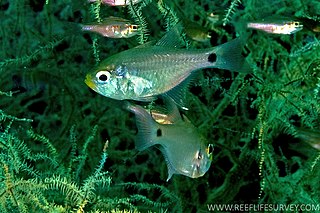
Cardinalfishes are a family, Apogonidae, of ray-finned fishes found in the Atlantic, Indian, and Pacific Oceans; they are chiefly marine, but some species are found in brackish water and a few are found in fresh water. A handful of species are kept in the aquarium and are popular as small, peaceful, and colourful fish. The family includes about 370 species.

Apogon is a large genus of fish in the family Apogonidae, the cardinalfishes. They are among the most common fish on coral reefs. Over 200 species have been classified in genus Apogon as members of several subgenera. Some of these subgenera, such as Ostorhinchus, have been elevated to genus status, leaving just over 50 species in the genus.

Nectamia is a genus of cardinalfishes native to the Indian Ocean and the western and central Pacific Ocean.

Apogonichthyoides is a genus of fish in the family Apogonidae, the cardinalfishes. They are native to the Indian Ocean and the western Pacific Ocean.

Cercamia is a genus of fishes in the family Apogonidae, the cardinalfishes. They are native to the Pacific and Indian Oceans.

Cheilodipterus is a genus of fishes in the family Apogonidae, the cardinalfishes. They are native to the Indian Ocean and the western Pacific Ocean.

Foa is a genus of fishes in the family Apogonidae, the cardinalfishes, native to the Indian and Pacific Oceans.

Fowleria is a genus of fishes in the family Apogonidae native to the Indian and Pacific Oceans. The name of this genus honors the American ichthyologist Henry Weed Fowler ( ) of the Academy of Natural Sciences of Philadelphia, who attended Stanford University, where he was a student of David Starr Jordan's.

Gymnapogon is a genus of fish in the family Apogonidae. They are native to the Indo-West Pacific and central Pacific Oceans, where they occur in reefs and nearby habitat types. These species are usually no more than 5 centimeters long and have semitransparent bodies without scales. The genus name is a compound noun formed by combining the Greek gymnos meaning "naked", referring to the lack of scales in the type species, Gymnapogon japonicus, and Apogon, the type genus of the Apogonidae. One species, the B-spot cardinalfish, is notable for its larvae being rather large, conspicuous and fast-swimming.

Holapogon maximus, the titan cardinalfish, is a species of ray-finned fish in the family Apogonidae, the cardinalfishes. This species is the only known member of the genus Holapogon. It is native to the Arabian coast and the Gulf of Oman, and it has recently been recorded from the coast of India. It lives at depths of from 83 to 100 m. This species grows to a total length of 25 cm (9.8 in).
Lachneratus phasmaticus, also known as the phantom cardinalfish, is a species of fish in the family Apogonidae, the cardinalfishes. It is the only member of its genus. It is native to the tropical eastern Pacific and Indian Oceans. This fish can be found in crevices and underwater caves, and it occurs at depths of 3 to 104 m. It grows to a standard length of 7.4 cm (2.9 in).

Phaeoptyx is a genus of cardinalfishes native to the western Atlantic Ocean.

Pristicon is a genus of cardinalfishes native to the western Pacific Ocean.
Pseudamiops is a genus of cardinalfishes native to the Pacific and Indian oceans.

Rhabdamia is a genus of cardinalfishes native to the Indian and Pacific Oceans.

Archamia bleekeri, also known as Gon's cardinalfish, is a species of fish in the family Apogonidae, the cardinalfishes. It is native to the coastal waters of the Indian Ocean and the western Pacific Ocean from Africa to Indonesia and from Taiwan to Queensland, Australia. This species occurs in mangrove forests and reefs, and is an inhabitant of shipwrecks, preferring silty areas with muddy or sandy substrates. This species grows to a total length of 10 cm (3.9 in). This species is the only member of its genus. The other species were moved to the new genus Taeniamia in 2013.

Taeniamia is a genus of cardinalfishes native to the Indian Ocean and the western Pacific Ocean.
The Sailfin cardinalfish is a species of ray-finned fish from the family Apogonidae, the cardinalfishes, and the only member of its genus. It is a large, almost all-black cardinal fish which is endemic to coral reefs in Western Australia. They are not yet common in the Aquarium trade, and are nocturnal.

The Apogoninae are the most species-rich and, of its shape, size, color and habitat, most diverse subfamily of cardinalfishes (Apogonidae). It can be found in coastal tropical and subtropical regions of the Indian Ocean, the eastern Pacific and the Atlantic, down to depths of 300 meters.

The Kurtiformes consist of two extant families of ray-finned fish, the Indo-Pacific Kurtidae and the much more diverse and widespread Apogonidae. The order is part of the Percomorpha clade and is regarded by many authorities as a sister taxon to the Gobiiformes.

















